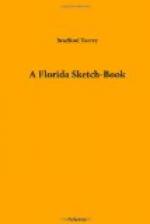Nearer the track were the omnipresent blackberry vines, some patches of which are especially remembered for their bright rosy flowers.
Out of the dense vegetation of a swamp came the cries of Florida gallinules, and then, of a sudden, I caught, or seemed to catch, the sweet kurwee whistle of a Carolina rail. Instinctively I turned my ear for its repetition, and by so doing admitted to myself that I was not certain of what I had heard, although the sora’s call is familiar, and the bird was reasonably near. I had been taken unawares, and every ornithologist knows how hard it is to be sure of one’s self in such a case. He knows, too, how uncertain he feels of any brother observer who in a similar case seems troubled by no distrust of his own senses. The whistle, whatever it had been, was not repeated, and I lost my only opportunity of adding the sora’s name to my Florida catalogue—a loss, fortunately, of no consequence to any but myself, since the bird is well known as a winter visitor to the State.
Further along, a great blue heron was stalking about the edge of a marshy pool, and further still, in a woody swamp, stood three little blue herons, one of them in white plumage. In the drier and more open parts of the way cardinals, mocking-birds, and thrashers were singing, ground doves were cooing, quails were prophesying, and loggerhead shrikes sat, trim and silent, on the telegraph wire. In the pine lands were plenty of brown-headed nuthatches, full, as always, of friendly gossip; two red-shouldered hawks, for whom life seemed to wear a more serious aspect; three Maryland yellow throats; a pair of bluebirds, rare enough now to be twice welcome; a black-and-white creeper, and a yellow redpoll warbler. In the same pine woods, too, there was much good music: house wrens, Carolina wrens, red-eyed and white-eyed vireos, pine warblers, yellow-throated warblers, blue yellowbacks, red-eyed chewinks, and, twice welcome, like the bluebirds, a Carolina chickadee.
A little beyond this point, in a cut through a low sand bank, I found two pairs of rough-winged swallows, and stopped for some time to stare at them, being myself, meanwhile, a gazing-stock for two or three negroes lounging about the door of a cabin not far away. It is a happy chance when a man’s time is doubly improved. Two of the birds—the first ones I had ever seen, to be sure of them—perched directly before me on the wire, one facing me, the other with his back turned. It was kindly done; and then, as if still further to gratify my curiosity, they visited a hole in the bank. A second hole was doubtless the property of the other pair. Living alternately in heaven and in a hole in the ground, they wore the livery of the earth.
“They are not fair to
outward view
As many swallows be,”
I said to myself. But I was not the less glad to see them.




